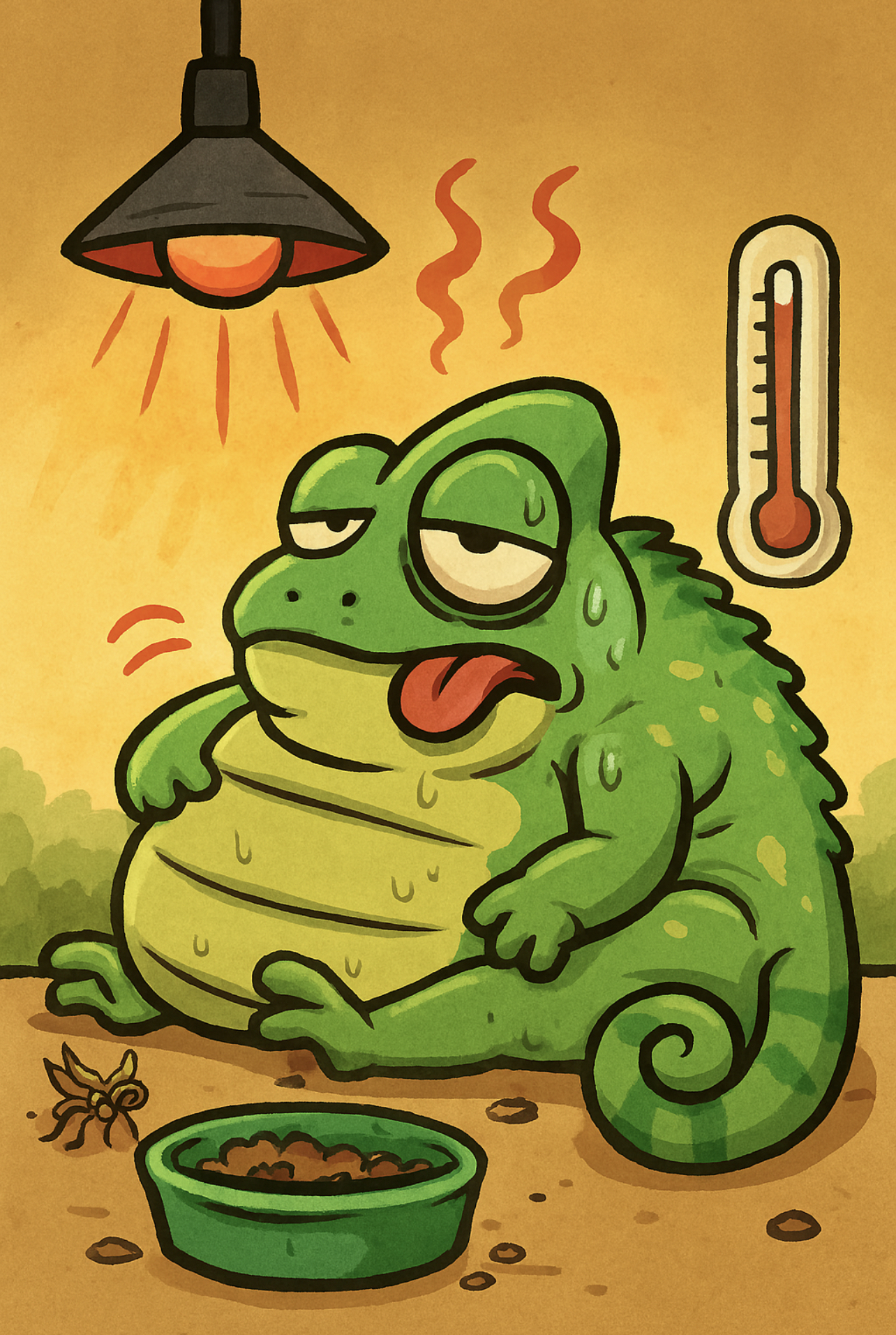Myth 24: “How Much You Feed Depends on the Age of Your Chameleon”

Reality: This is misleading.
Age alone does not determine feeding quantity—especially when it comes time to reduce food intake.
Many keepers believe that chameleons under one year of age should be fed ad libitum (as much as they want). Others claim chameleons can self-regulate and "know when they've had enough." Both assumptions are false.
Growth Rate Is Highly Individual
In the wild, growth tends to be synchronized—either by seasonal hatching or clutch timing. In captivity, however, growth rates vary dramatically. For example, a Chamaeleo calyptratus measuring 20 cm in total length could be anywhere from 2 months to 12 months old without heath issues tied with too rapid or too slow growth rate.
Growth rate is influenced by:
Ambient temperatures
Type and quantity of food
Light spectrum and photoperiod
Supplementation
Health status
Exposure to microplastics or toxins
etc.
This variability makes it virtually impossible to determine a chameleon's age based on size alone.
Feeding Patterns in Juveniles
Young chameleons channel nearly all their energy into basal metabolism and growth. They rarely become overweight—unless affected by an unusual pathology , genetic disorder or disease. In nature, they feed ad libitum, but food availability is limited, so they must work hard to find it.
In captivity, ad libitum feeding can lead to overconsumption. Fortunately, growing juveniles often self-regulate by refusing food once they've had enough. However, as they approach their maximum size, they begin storing energy as fat—and that's when feeding must be adjusted.
Why Adult Chameleons Require Reduced Feeding
Overfeeding adult chameleons can lead to:
Obesity, which causes infertility, organ dysfunction, and slow death
Excessive egg production in females, as the number of activated follicles is directly proportional to fat and calcium reserves
In Chamaeleo calyptratus, normal clutch size ranges from 25–40 eggs. With excessive fat reserves, this can spike to 121 eggs, causing:
Egg retention
Exhaustion
Metabolic disorders
Anatomical constraints: organs can be squeezed and their function impaired, blood flow can be alterated
Severe health complications
Any clutch exceeding 45 eggs is a red flag for overfeeding.
Can You Tell When Maximum Size Is Reached?
Not reliably. Just as humans reach adulthood anywhere between 135–200 cm, chameleons also vary widely. While each species has an average maximum size, individuals rarely conform to the average.
You can make educated guesses based on (if known):
Species
Local form
Parental size
But these guesses are highly unreliable due to genetic and environmental variability.
Two Reliable Methods to Know When to Reduce Feeding
1. Approximate Method (Experience-Based)
Watch for early signs of obesity:
Heavier body mass
Edematous appearance
No visible ribs during breathing
Bulging eyes when sleeping head-down
If you see:
A large belly
Swollen cheeks
Enlarged casque
…you've already missed the optimal window and must drastically reduce feeding.
With experience—or guidance from an expert—you can fine-tune feeding in a sinusoidal pattern:
If the chameleon becomes overweight, reduce feeding
If it gets too lean, increase feeding or offer more nutritious prey
2. Exact Method (Measurement-Based)
Track growth precisely:
When length stops increasing but weight continues to rise, it's time to reduce feeding.
Physiological norms fail due to individual variation—some chameleons are naturally heavier or lighter.
Use:
Precision scales
Manual measurements
Remote tools (e.g., photo-based apps with scale references)
Regular tracking helps to:
Determine feeding needs
Detect early signs of health issues
So, How Much Should You Feed?
There's no universal standard. Energy balance is individual, and in reptiles, metabolic rate is heavily influenced by temperature:
Lower tempertures = slower metabolism, longer life
Higher temperatures = faster metabolism, shorter life
Practical Feeding Recommendations
Juveniles in Growth Phase
Simplistic approach: Feed ad libitum—as much as they'll eat.
Wild safety: In nature, they're evolutionarily tuned to their environment.
Captive caution: Fast growth without proper UV exposure or balanced supplements can cause developmental issues.
Safe approach: Feed once or twice daily, offering as much as they'll eat in one sitting.
Gravid Females
Same approach as growing juveniles—nutrient demand is high.
Adults
Most keepers are shocked by how little adult chameleons actually need:
Chamaeleo calyptratus: ~1 large cricket per day, or every other day
Furcifer pardalis: ~2x more due to larger body and different physiology
all this applies if kept under normal conditions, not simullating the hot period of the year (which unfortunately, many keepers do).
Important:
Overheating increases appetite and shortens lifespan
Overfeeding + overheating in females = large clutches, exhaustion, early death
Final Thought
Feed wisely. Use science, observation, and common sense.
Be responsible and ethical in your care.